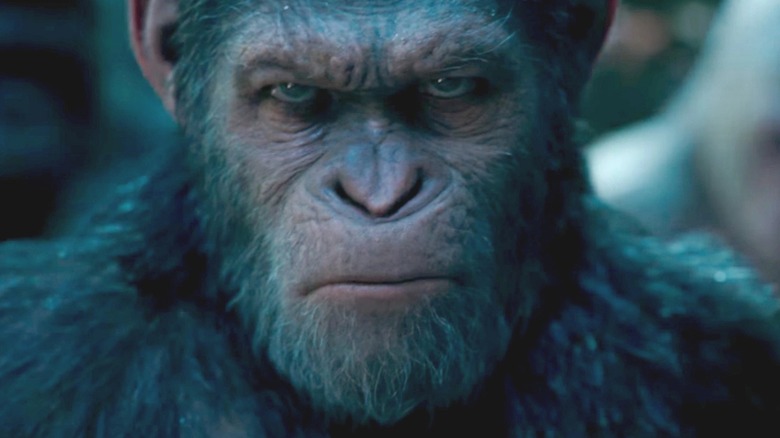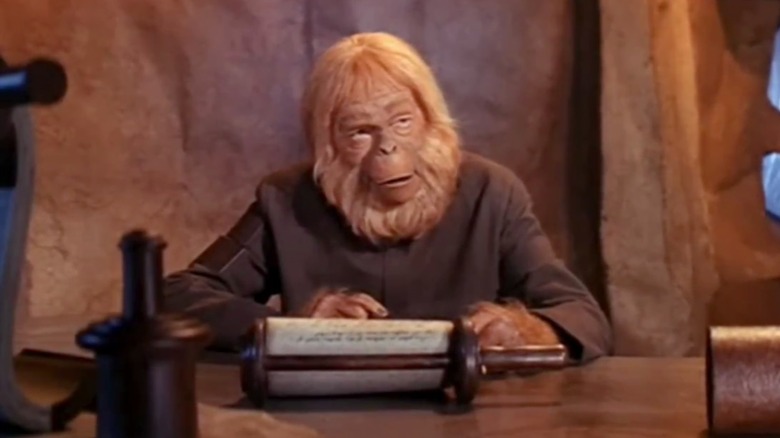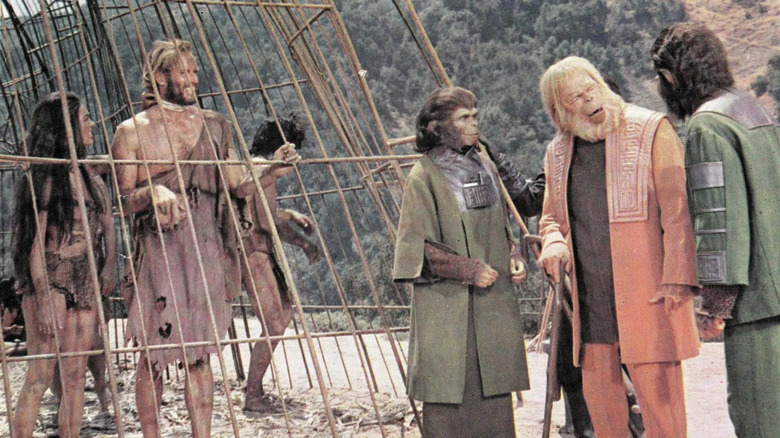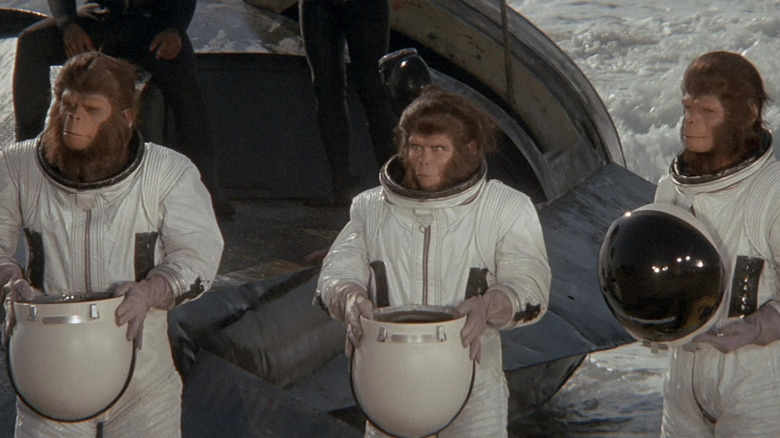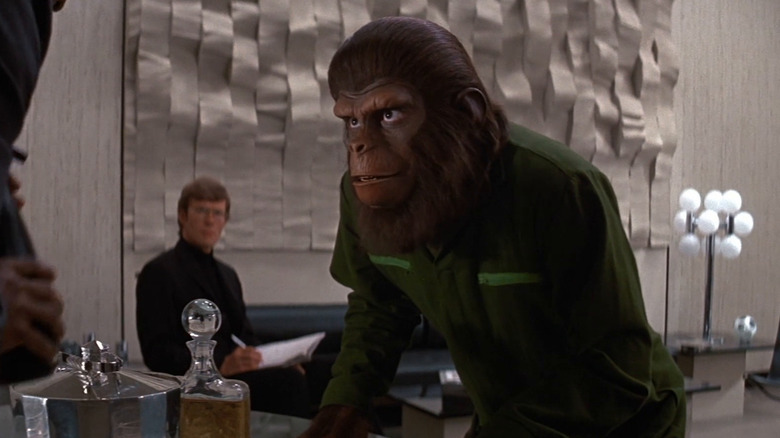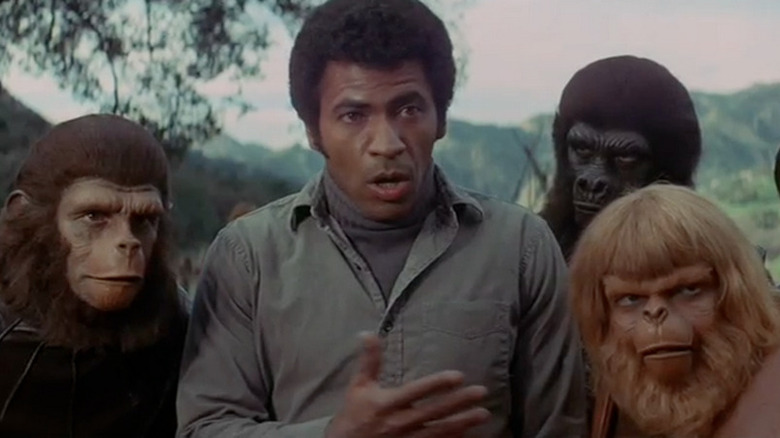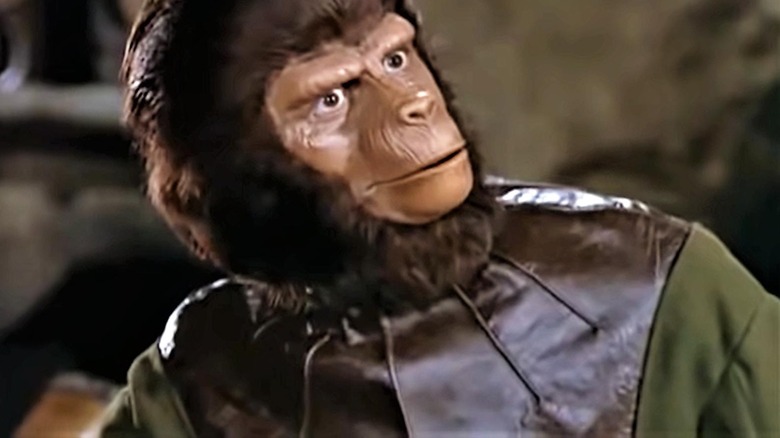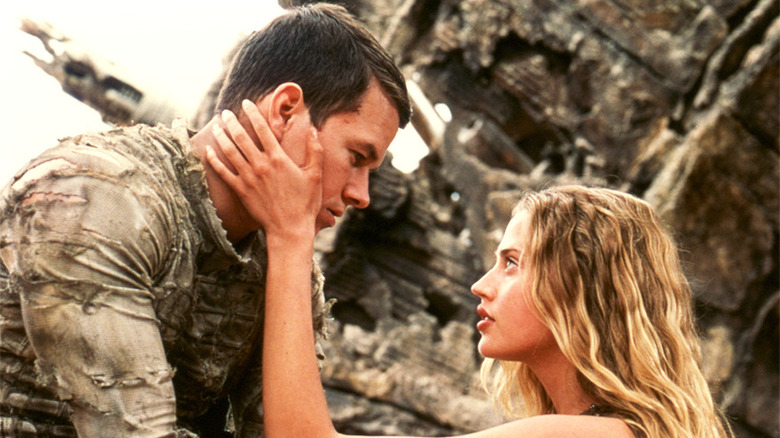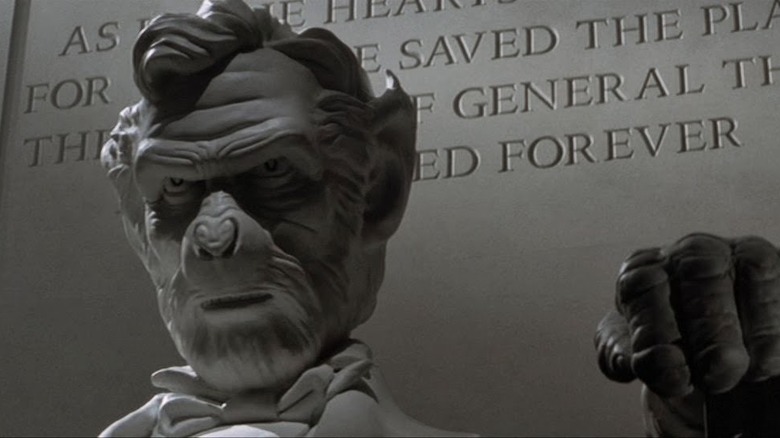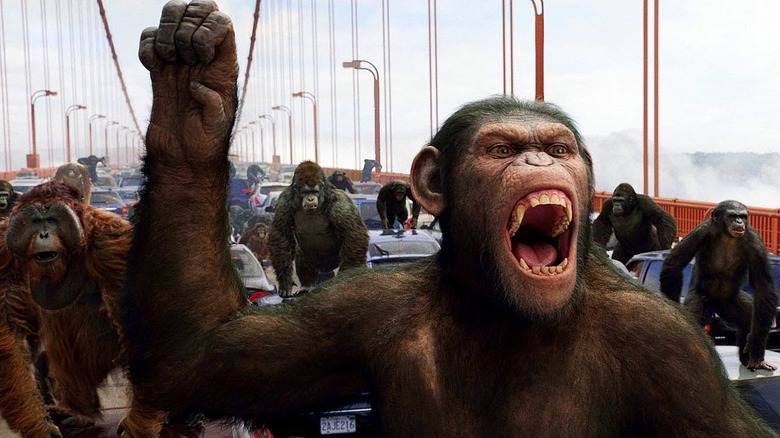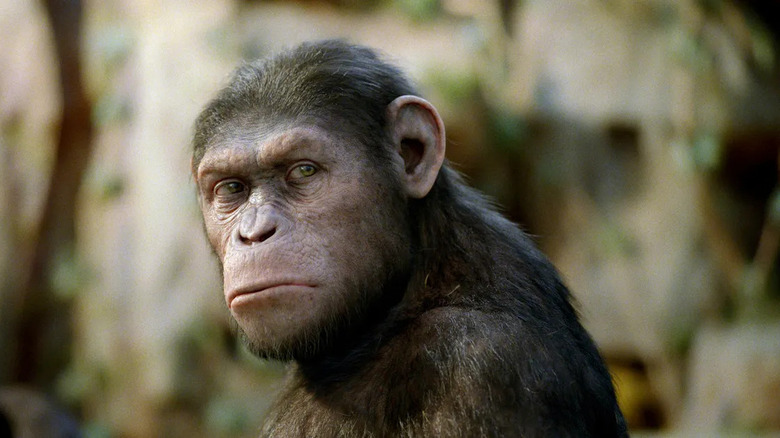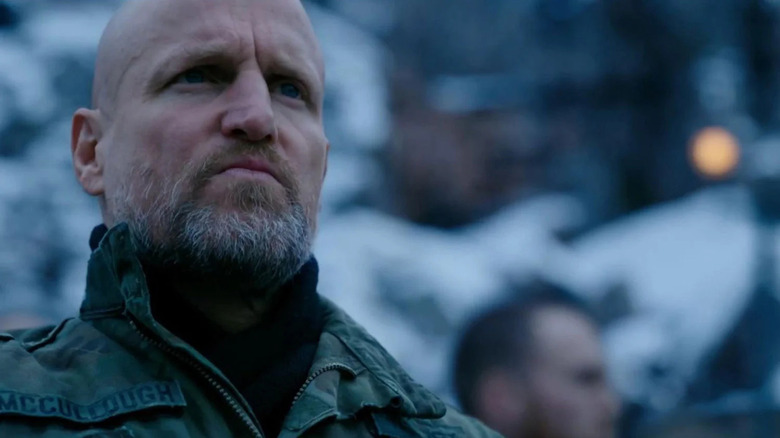The Biggest Plot Holes In The Planet Of The Apes Franchise
One of the most enduring science fiction multimedia franchises in Hollywood is "Planet of the Apes," based on Pierre Boulle's 1963 novel of the same name. Adapted into a hit feature film in 1968, "Planet of the Apes" spawned a line of sequels, television spin-offs, and an entire wave of merchandising. After a reboot in 2001 helmed by Tim Burton, the franchise was revived with 2011's "Rise of the Planet of the Apes," a surprise hit that led to its own set of sequels.
However, as successful and extensive as the "Planet of the Apes" franchise is, it is not without its glaring plot holes, visible narrative inconsistencies, and generally confusing moments that are never fully resolved. With contradictory plot points within the film series, genuinely bizarre cliffhanger endings, and forced narrative developments, "Planet of the Apes" has played fast and loose with its continuity in the past. Here are the most egregious plot holes and confusing moments in the "Planet of the Apes" franchise, from its 1968 debut to its most recent chapter.
How did the apes learn to talk in the first place?
More than simply becoming intelligent enough to form their own civilization and subjugate humanity, the apes throughout the "Planet of the Apes" franchise can speak English and communicate with each other and humans. The 2001 reboot and the revival series that began with 2011's "Rise of the Planet of the Apes" each explain this development to be the result of genetic engineering that significantly boosted their intelligence. However, the classic film series provides a sillier rationale for the apes to gain such human-like qualities and heightened intellectual capacity, avoiding the more overtly science fiction elements in favor of social commentary.
The 1972 film "Conquest of the Planet of the Apes" reveals that the Earth is overcome by a pandemic in 1983 that wipes out conventional household pets, including cats and dogs. This troubling development leads humanity to widely adopt apes as its new pets, before they are systematically forced into manual labor as totalitarian governments come into power worldwide. Through this increased proximity and education from humans, apes eventually learn how to speak before banding together to overthrow their cruel overseers in one of the franchise's bigger leaps in logic.
How does humanity lose its intellectual capacity?
When astronaut George Taylor (Charlton Heston) crashes on a future Earth ruled by apes, with humanity hunted and abused by their simian overlords, he quickly discovers that the humans of this era are far less capable than those he left behind. Taylor's attempts to acclimate to this harsh world are further complicated by the fact that humanity has largely been rendered mute and features a noticeably reduced intellectual capacity. Though this diminishment in intelligence is spelled out in the revival series and ignored completely in the 2001 reboot, it is more awkwardly explained away in the original movies.
The 1970 film "Beneath the Planet of the Apes" reveals that the nuclear war that devastated Earth and caused the collapse of human civilization resulted in humans becoming wilder and more feral in the ruins of the old world. 1973's "Battle for the Planet of the Apes" takes place after nuclear armageddon but contradictorily depicts humans maintaining a sense of civility and the ability to speak. The revival series' "War for the Planet of the Apes" sidesteps the matter entirely, by revealing a mutated virus transmitted by simians debilitatingly affects cognitive function in humans to account for the diminishment.
How did Cornelius and Zira escape Armageddon?
"Beneath the Planet of the Apes" ends with what appears to be a definitive conclusion for the franchise as Taylor triggers a doomsday nuclear warhead in his dying moments that destroys the entire Earth. However, not even the end of the world could derail the "Planet of the Apes" series, with a direct sequel in 1971's "Escape from the Planet of the Apes" effectively canceling the apocalypse. The film has intelligent chimpanzees Cornelius (Roddy McDowall), Zira (Kim Hunter), and Milo (Sal Mineo) use Taylor's spaceship to travel back centuries to 1973 in a reversal to the original premise.
Though the prospect of seeing how the intelligent apes react to a world ruled by humans is intriguing, their time-traveling odyssey makes little sense under additional scrutiny. Despite living in a relatively primitive society, with guns as their most advanced technology, the apes are able to repair Taylor's crashed spaceship sufficiently enough to escape Earth, navigate through space, and travel back in time. This development is made all the more nonsensical when you take into account that "Beneath the Planet of the Apes" takes place only a short time after the original film, making these extensive repairs all the more unlikely.
Does Caesar's presence cause a predestination paradox?
The revival trilogy of the 2010s positions Caesar as the savior of the apes, the revolutionary who leads the simians to conquer the planet and drive cruel human despots into submission. However, Caesar's history and role in the classic film series is considerably more complicated, as the time-displaced son of Cornelius and Zira who grows up on Earth in the 1970s and '80s. Inheriting his parents' intelligence, Caesar becomes the key figure in leading the ape rebellion to overthrow their brutal human overseers, but his presence raises questions about the nature of destiny.
It is Caesar who leads his fellow apes to take up arms against the humans in "Conquest of the Planet of the Apes." This suggests that Caesar was always destined to lead the apes and create the far-future society seen in "Planet of the Apes" after the devastating nuclear apocalypse. This predestination paradox indicates that the conflict between the apes and humanity has been in a constant cycle, with Cornelius and Zira endlessly traveling back in time to effectively set the foundation for their own future. There is also the possibility that the apes in the original timeline could have been led by a different revolutionary: in "Escape from the Planet of the Apes," Cornelius mentions that an ape named Aldo is the first in their history to talk back to his human masters.
Is the animosity between apes and humans averted?
The final film in the classic continuity, "Battle for the Planet of the Apes," takes place after Earth has been devastated by nuclear warfare and human society has effectively collapsed. The resulting conflict has apes battle mutant humans for planetary supremacy, while ape leader Caesar (Roddy McDowall) contends with traitorous elements among his ranks. Though this sweeping war initially appears to resolve the story of how apes conquered the post-apocalyptic world, the movie's final scene suggests Caesar may have changed history.
In an epilogue six centuries after Caesar defeats the mutants and solidifies power, humans and apes are seen coexisting together and listening to the story of his heroism in bringing their people together. While "Conquest of the Planet of the Apes" indicates it's Caesar who causes the rise of the apes all along, a premise echoed by the revival series, Caesar learns of his parents' future over the course of the movie. This revelation presumably informs his decision to have humans and apes live together peacefully, though this raises wider questions about the timeline and overarching impact caused by the change. With Caesar changing history, he may have prevented a future where he and his parents were born, effectively creating a temporal paradox though the implications of this change in history are never addressed in the film.
The Planet of the Apes TV series' odd continuity
After the initial run of "Planet of the Apes" movies ended in 1973, the franchise continued with a live-action television series that premiered in 1974. Set in 3085, approximately 400 years after the peaceful epilogue to "Battle for the Planet of the Apes," the show is also set 900 years before Taylor arrives on Earth from the 20th century. The show follows two different astronauts, Alan Virdon (Ron Harper) and Peter Burke (James Naughton), who accidentally travel into the future from the 20th century to find humanity subjugated by intelligent apes.
There are several elements in the television series that directly contradict the depiction of the far future from the movies, without any explanation given. Despite a contagion killing off conventional house pets in the 20th century in the movies, the series premiere features a dog, suggesting pets weren't completely rendered extinct. The human characters native to this futuristic timeline can also speak, in contrast to the largely mute human population from the movies. Most confusingly, the ape leader Zaius (Booth Colman) indicates he has encountered time-traveling human astronauts before, hinting at Taylor's arrival even though the latter is not scheduled to arrive for almost a millennium.
Why does Leo go to Earth after leaving the far future?
The 2001 "Planet of the Apes" reboot directed by Tim Burton has astronaut Leo Davidson (Mark Wahlberg) flung millennia into the future after entering a cosmic storm during a mission in 2029. After resolving the conflict between humans and intelligent apes on the faraway planet of Ashlar, Leo finds a serviceable space pod and decides to leave the strange planet for good. Emerging from Ashlar's orbit, Leo discovers the same cosmic phenomenon and uses it to conveniently travel back to his own time period, where he proceeds to return to Earth.
This destination is not only a hasty decision but also an immensely selfish one on Leo's part, given what he learns about Ashlar and his friends during his time in the future. While on Ashlar, Leo discovers that the humans and apes on the planet are descendants of the survivors from the Oberon, Leo's ship that followed him into the cosmic storm after he disappeared. Leo makes no effort to contact the Oberon upon returning to the past, nor does he visibly plot his trajectory into the storm to arrive in time to warn them and avert their grim fate. Instead, Leo makes a beeline straight for home only to find something far more sinister awaiting him once he finally makes it back to Earth.
How did General Thade completely reshape Earth?
The big twist ending to the 2001 "Planet of the Apes" reboot sees Leo travel back to his own time in the early 21st century and crash-land in Washington, D.C. As Leo regains his bearings, he wanders into the nearby Lincoln Memorial only to discover that the statue of President Abraham Lincoln has been replaced by the villainous chimpanzee General Thade (Tim Roth). As Leo reacts with horror, he is apprehended by ape police, with ape news crews approaching the crash site, all dressed in modern clothing. Given that Thade was last seen trapped in the wreckage of the Oberon on Ashlar, millennia in the future, this twist feels like it was created more for shock value than logically earned.
In order for Thade to conquer Earth, he presumably would have had to make the Oberon operational enough to leave Ashlar and survive the trip through the cosmic storm. Thade would then have to figure out how to pilot the Oberon to Earth and arrive long before Leo makes his own return voyage, raising enough of an army to overtake the planet. Though a sequel to the reboot was initially commissioned by the studio (via Entertainment Weekly), the project's cancellation effectively meant this cliffhanger ending would never be resolved.
How did Caesar amass such a large army so quickly?
The revived "Planet of the Apes" film series that begins with "Rise of the Planet of the Apes" reimagines Caesar as a chimpanzee whose intelligence is artificially boosted in a genetics experiment. As Caesar contends with cruel figures in the pharmaceutical company that funds the compound which enhances his intellect, he decides to rise up and liberate his fellow apes in captivity. To facilitate this revolution, Caesar steals a sample of the experimental drug compound and uses it to enhance the intelligence of captive apes in the test facility and local zoo.
What makes Caesar's rallying cry during the 2011 film's climactic battle somewhat puzzling is that Caesar's makeshift army quickly and unexpectedly grows to the point where the apes swarm all over the Golden Gate Bridge. With such an extensive army, Caesar and the apes completely overwhelm the human authorities, achieve revenge against the pharmaceutical company, and manage to escape San Francisco en masse. Given the sheer number of apes seen onscreen during the final battle, it raises the question of how many apes Caesar liberated to make up his simian army. Quickly jumping from a matter of dozens to an entire army, Caesar may have discovered the secret mother lode of apes in the Bay Area to lead his revolution.
How did Caesar's tribe avoid military repercussions?
Rather than have humanity collapse as a result of nuclear warfare, the "Planet of the Apes" revival series has civilization implode due to a deadly and highly contagious virus introduced in "Rise of the Planet of the Apes." Referred to in later films as the Simian Flu, the pandemic springs from a genetic compound, created to ostensibly cure Alzheimer's, which instead leads to rapidly lethal consequences. By "Dawn of the Planet of the Apes," the intelligent apes led by Caesar are widely blamed for the outbreak, though the apes live in relative tranquility within the Muir Forest at the start of the film.
Caesar and the apes set up their home in the California forest at the end of "Rise of the Planet of the Apes," leaving the question of why their refuge goes undisturbed in the 10 years between movies. With the apes' uprising at the end of "Rise of the Planet of the Apes" witnessed by the world, it is a wonder that the government doesn't bomb their forest home in an effort to contain the pandemic. With the world presumably descending into chaos in the face of the contagion, a coordinated military response may not be possible, but "Dawn of the Planet of the Apes" confirms that humans know where Caesar and his tribe are all along.
Why are there two human armies at war?
The climactic battle in "War for the Planet of the Apes" isn't exclusively between apes and humans, but with Colonel McCullough's forces taking on a human military force attacking their base. Over the course of the film, Caesar deduces that McCullough has gone rogue and is leading his own proactive paramilitary force against the remaining military's post-apocalyptic efforts. This culminates in a pitched assault on McCullough's compound nestled under a snowy mountain, with the fierce fighting triggering an avalanche that completely overwhelms human soldiers on both sides of the battle.
With humanity in ruins and on a steady decline due to the mutated Simian Flu, the concept of well-organized human militaries going out of their way to battle for supremacy feels tacked-on. McCullough is a formidable enough threat on his own and, as the mutated virus sweeps across the planet, the idea that he is being hunted by other humans in a coordinated military strike is too far a leap in logic. McCullough implies that he is fighting his human adversaries because his methodology to contain the mutated virus is too extreme, but this comes off as odd given the further societal decay. Raising more questions than it answers with this plot device, "War for the Planet of the Apes" is held back narratively by this questionable inclusion in the finale.
